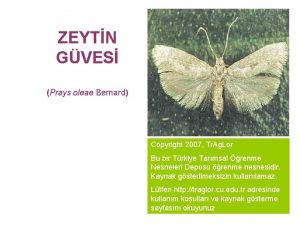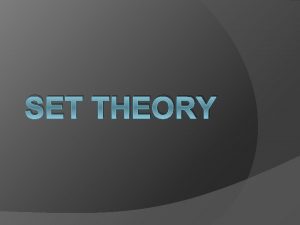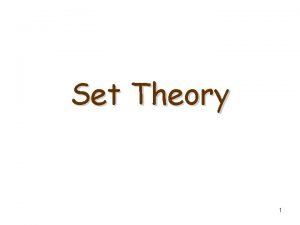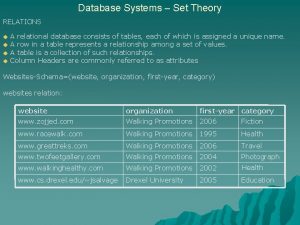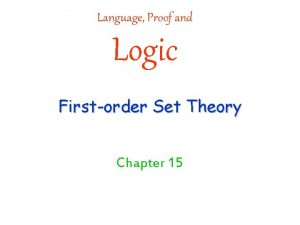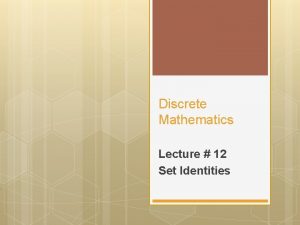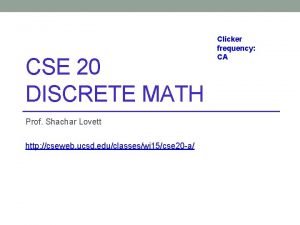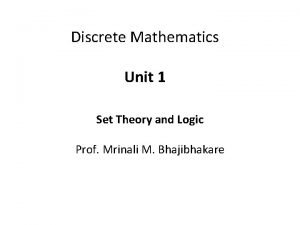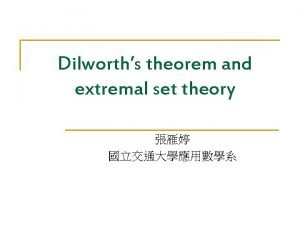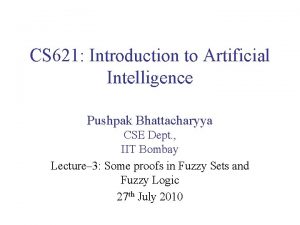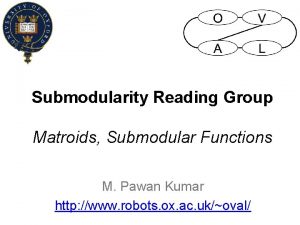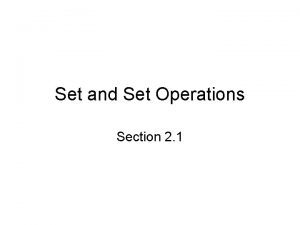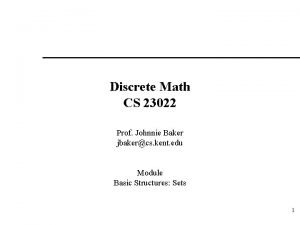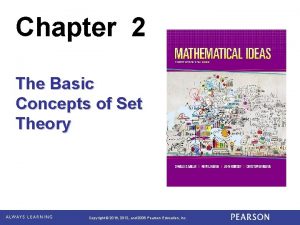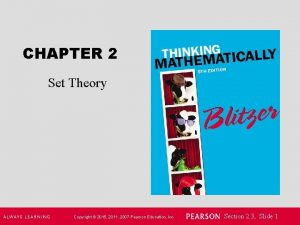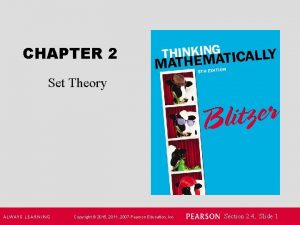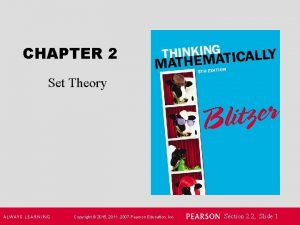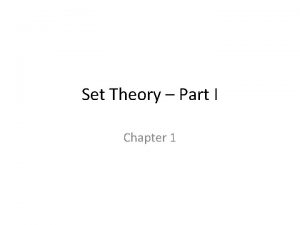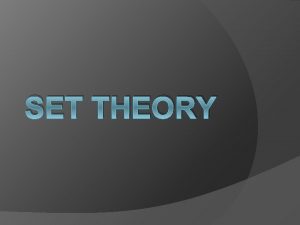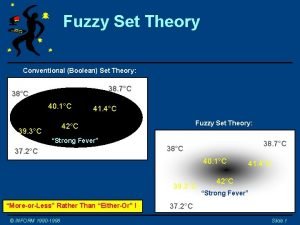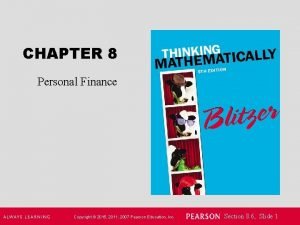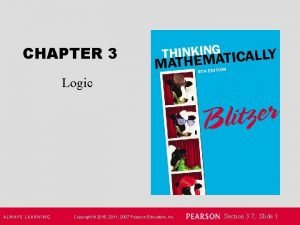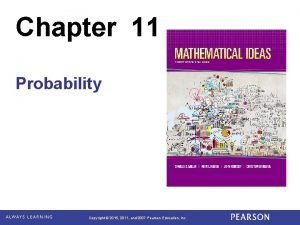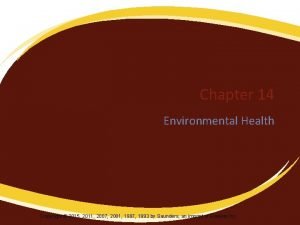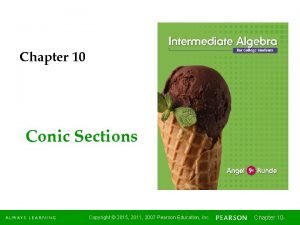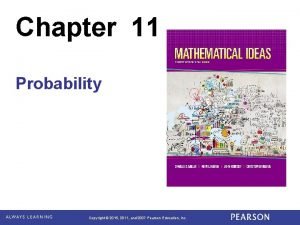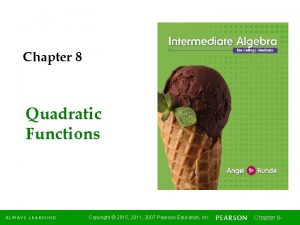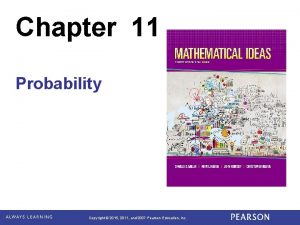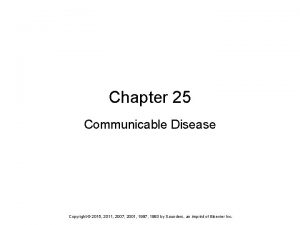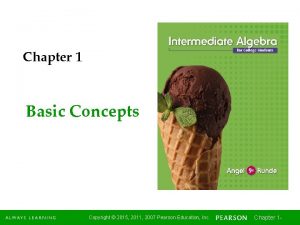CHAPTER 2 Set Theory Copyright 2015 2011 2007






























- Slides: 30

CHAPTER 2 Set Theory Copyright © 2015, 2011, 2007 Pearson Education, Inc. Section 2. 1, Slide 1

2. 1 Basic Set Concepts Copyright © 2015, 2011, 2007 Pearson Education, Inc. Section 2. 1, Slide 2

Objectives 1. 2. 3. 4. 5. 6. 7. 8. Use three methods to represent sets. Define and recognize the empty set. Use the symbols and . Apply set notation to sets of natural numbers. Determine a set’s cardinal number. Recognize equivalent sets. Distinguish between finite and infinite sets. Recognize equal sets. Copyright © 2015, 2011, 2007 Pearson Education, Inc. Section 2. 1, Slide 3

Sets A collection of objects whose contents can be clearly determined. Elements or members are the objects in a set. A set must be well-defined, meaning that its contents can be clearly determined. The order in which the elements of the set are listed is not important. Copyright © 2015, 2011, 2007 Pearson Education, Inc. Section 2. 1, Slide 4

Methods for Representing Sets Capital letters are generally used to name sets. Word description: Describing the members: Set W is the set of the days of the week. Roster method: Listing the members: W = {Monday, Tuesday, Wednesday, Thursday, Friday, Saturday, Sunday}. Commas are used to separate the elements of the set. Braces, { }, are used to designate that the enclosed elements form a set. Copyright © 2015, 2011, 2007 Pearson Education, Inc. Section 2. 1, Slide 5

Example: Representing a Set Using a Description Write a word description of the set: P = {Washington, Adams, Jefferson, Madison, Monroe}. Solution Set P is the set of the first five presidents of the United States. Copyright © 2015, 2011, 2007 Pearson Education, Inc. Section 2. 1, Slide 6

Example: Representing a Set Using the Roster Method Write using the roster method: Set C is the set of U. S. coins with a value of less than a dollar. Express this set using the roster method. Solution C = {penny, nickel, dime, quarter, half-dollar} Copyright © 2015, 2011, 2007 Pearson Education, Inc. Section 2. 1, Slide 7

Set-Builder Notation We read this notation as “Set W is the set of all elements x such that x is a day of the week. ” Before the vertical line is the variable x, which represents an element in general. After the vertical line is the condition x must meet in order to be an element of the set. Copyright © 2015, 2011, 2007 Pearson Education, Inc. Section 2. 1, Slide 8

Example: Converting from Set-Builder to Roster Notation Express set A = {x | x is a month that begins with the letter M} using the roster method. Solution There are two months, namely March and May. Thus, A = { March, May}. Copyright © 2015, 2011, 2007 Pearson Education, Inc. Section 2. 1, Slide 9

The Empty Set These are examples of empty sets: Set of all numbers less than 4 and greater than 10 {x | x is a fawn that speaks} Copyright © 2015, 2011, 2007 Pearson Education, Inc. Section 2. 1, Slide 10

Example: Recognizing the Empty Set Which of the following is the empty set? a. {0} No. This is a set containing one element. b. 0 No. This is a number, not a set. Copyright © 2015, 2011, 2007 Pearson Education, Inc. Section 2. 1, Slide 11

Example: Recognizing the Empty Set Which of the following is the empty set? c. {x | x is a number less than 4 or greater than 10} No. This set contains all numbers that are either less than 4, such as 3, or greater than 10, such as 11. d. {x | x is a square with three sides} Yes. There are no squares with three sides. Copyright © 2015, 2011, 2007 Pearson Education, Inc. Section 2. 1, Slide 12

Notations for Set Membership Copyright © 2015, 2011, 2007 Pearson Education, Inc. Section 2. 1, Slide 13

Example: Using the Symbols and Determine whether each statement is true or false: a. r {a, b, c, …, z} True b. 7 {1, 2, 3, 4, 5} True c. {a} {a, b} False. {a} is a set and the set {a} is not an element of the set {a, b}. Copyright © 2015, 2011, 2007 Pearson Education, Inc. Section 2. 1, Slide 14

Sets of Natural Numbers The three dots, or ellipsis, after the 5 indicate that there is no final element and that the list goes on forever. Copyright © 2015, 2011, 2007 Pearson Education, Inc. Section 2. 1, Slide 15

Example: Representing Sets of Natural Numbers Express each of the following sets using the roster method: a. Set A is the set of natural numbers less than 5. A = {1, 2, 3, 4} b. Set B is the set of natural numbers greater than or equal to 25. B = {25, 26, 27, 28, …} c. E = { x| x and x is even}. E = {2, 4, 6, 8, …} Copyright © 2015, 2011, 2007 Pearson Education, Inc. Section 2. 1, Slide 16

Inequality Notation and Sets Copyright © 2015, 2011, 2007 Pearson Education, Inc. Section 2. 1, Slide 17

Inequality Notation and Sets Copyright © 2015, 2011, 2007 Pearson Education, Inc. Section 2. 1, Slide 18

Example: Representing Sets of Natural Numbers Express each of the following sets using the roster method: a. {x | x and x ≤ 100} Solution: {1, 2, 3, 4, …, 100} b. {x | x and 70 ≤ x <100} Solution: {70, 71, 72, 73, …, 99} Copyright © 2015, 2011, 2007 Pearson Education, Inc. Section 2. 1, Slide 19

Cardinality and Equivalent Sets Repeating elements in a set neither adds new elements to the set nor changes its cardinality. Copyright © 2015, 2011, 2007 Pearson Education, Inc. Section 2. 1, Slide 20

Example: Cardinality of Sets Find the cardinal number of each of the following sets: a. A = { 7, 9, 11, 13 } n(A) = 4 b. B = {0} n(B) = 1 c. C = { 13, 14, 15, …, 22, 23} n(C)=11 Copyright © 2015, 2011, 2007 Pearson Education, Inc. Section 2. 1, Slide 21

Equivalent Sets Copyright © 2015, 2011, 2007 Pearson Education, Inc. Section 2. 1, Slide 22

Equivalent Sets These are equivalent sets: The line with arrowheads, , indicate that each element of set A can be paired with exactly one element of set B and each element of set B can be paired with exactly one element of set A. Copyright © 2015, 2011, 2007 Pearson Education, Inc. Section 2. 1, Slide 23

Equivalent Sets Copyright © 2015, 2011, 2007 Pearson Education, Inc. Section 2. 1, Slide 24

Example: Determining if Sets are Equivalent This figure shows the preferred age difference in a mate in five selected countries. A = the set of five countries shown B = the set of the average number of years women in each of these countries prefer men who are older than themselves. Are these sets equivalent? Explain. Copyright © 2015, 2011, 2007 Pearson Education, Inc. Section 2. 1, Slide 25

Example continued Method 1: Trying to set up a One-to-One Correspondence. Solution: The lines with the arrowheads indicate that the correspondence between the sets is not one-to-one. The elements Poland Italy from set A are both paired with the element 3. 3 from set B. These sets are not equivalent. Copyright © 2015, 2011, 2007 Pearson Education, Inc. Section 2. 1, Slide 26

Example continued Method 2: Counting Elements Solution: Set A contains five distinct elements: n(A) = 5. Set B contains four distinct elements: n(B) = 4. Because the sets do not contain the same number of elements, they are not equivalent. Copyright © 2015, 2011, 2007 Pearson Education, Inc. Section 2. 1, Slide 27

Finite and Infinite Sets Copyright © 2015, 2011, 2007 Pearson Education, Inc. Section 2. 1, Slide 28

Equal Sets Copyright © 2015, 2011, 2007 Pearson Education, Inc. Section 2. 1, Slide 29

Example: Determining Whether Sets are Equal Determine whether each statement is true or false: a. {4, 8, 9} = {8, 9, 4} True b. {1, 3, 5} = {0, 1, 3, 5} False Copyright © 2015, 2011, 2007 Pearson Education, Inc. Section 2. 1, Slide 30
 Total set awareness set consideration set
Total set awareness set consideration set Training set validation set test set
Training set validation set test set Copyright 2015 all rights reserved
Copyright 2015 all rights reserved Copyright 2015 all rights reserved
Copyright 2015 all rights reserved Copyright 2007
Copyright 2007 Copyright 2007
Copyright 2007 Bounded set vs centered set
Bounded set vs centered set Fuzzy logic
Fuzzy logic Crisp set vs fuzzy set
Crisp set vs fuzzy set Crisp set vs fuzzy set
Crisp set vs fuzzy set What is the overlap of data set 1 and data set 2?
What is the overlap of data set 1 and data set 2? Surjective vs injective
Surjective vs injective Set theory in computer science
Set theory in computer science Cardinal number of a set
Cardinal number of a set What is set builder notation
What is set builder notation Properties of set theory
Properties of set theory Set theory database
Set theory database Set theory
Set theory Set identities table
Set identities table Set theory practice
Set theory practice Sets and propositions in discrete mathematics
Sets and propositions in discrete mathematics Sertöz theorem
Sertöz theorem Set theory operators
Set theory operators Rough set theory
Rough set theory Set theory
Set theory Cardinal number of a set
Cardinal number of a set Set theory
Set theory Basic concepts of set theory
Basic concepts of set theory World youth day spain
World youth day spain Microsoft windows small business server 2011 essentials
Microsoft windows small business server 2011 essentials Small business server 2011 end of life
Small business server 2011 end of life




